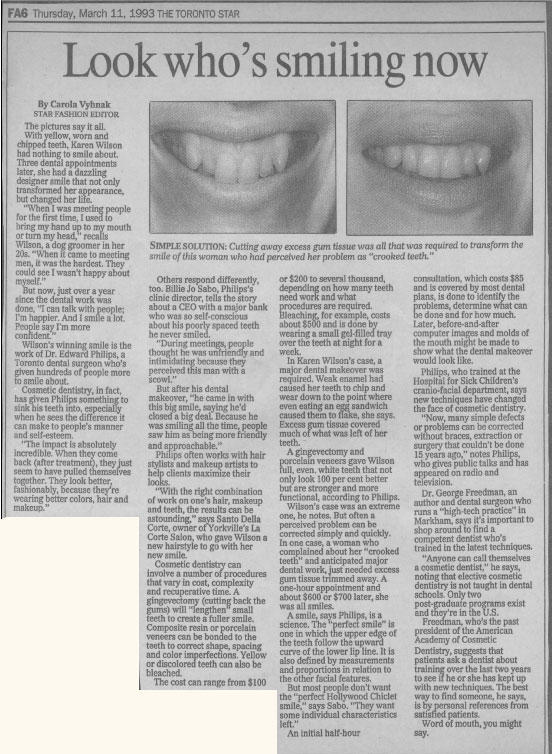Look who’s smiling now

By Carola Vyhnak
The pictures say it all.
With yellow, worn and chipped teeth, Karen Wilson had nothing to smile about. Three dental appointments later, she had a dazzling designer smile that not only transformed her appearance, but changed her life.
“When I was meeting people for the first time, I used to bring my hand up to my mouth or turn my head,” recalls Wilson, a dog groomer in her 20s. “When it came to meeting men, it was the hardest. They could see I wasn’t happy about myself.”
But now, just over a year since the dental work was done, “I can talk with people; I’m happier. And I smile a lot. People say I’m more confident.”
Wilson’s winning smile is the work of Dr. Edward Philips, a Toronto dental surgeon who’s given hundreds of people more to smile about.
Cosmetic dentistry, in fact, has given Philips something to sink his teeth into, especially when he sees the difference it can make to people’s manner and self-esteem.
“The impact is absolutely incredible. When they come back (after treatment), they just seem to have pulled themselves together. They look better, fashionably, because they’re wearing better colors, hair and makeup.”
Others respond differently, too. Billie Jo Sabo, Philips’s clinic director, tells the story about a CEO with a major bank who was so self-conscious about his poorly spaced teeth he never smiled.
“During meetings, people thought he was unfriendly and intimidating because they perceived this man with a scowl.”
But after his dental makeover, “he came in with this big smile, saying he’d closed a big deal. Because he was smiling all the time, people saw him as being more friendly and approachable.”
Philips often works with hair stylists and makeup artists to help clients maximize their looks.
“With the right combination of work on one’s hair, makeup and teeth, the results can be astounding,” says Santo Della Corte, owner of Yorkville’s La Corte Salon, who gave Wilson a new hairstyle to go with her new smile.
Cosmetic dentistry can involve a number of procedures that vary in cost, complexity and recuperative time. A gingevectomy (cutting back the gums) will “lengthen” small teeth to create a fuller smile. Composite resin or porcelain veneers can be bonded to the teeth to correct shape, spacing and color imperfections. Yellow or discolored teeth can also be bleached.
The cost can range from $100 or $200 to several thousand, depending on how many teeth need work and what procedures are required. Bleaching, for example, costs about $500 and is done by wearing a small gel-filled tray over the teeth at night for a week.
In Karen Wilson’s case, a major dental makeover was required. Weak enamel had caused her teeth to chip and wear down to the point where even eating an egg sandwich caused them to flake, she says. Excess gum tissue covered much of what was left of her teeth.
A gingevectomy and porcelain veneers gave Wilson full, even, white teeth that not only look 100 per cent better but are stronger and more functional, according to Philips.
Wilson’s case was an extreme one, he notes. But often a perceived problem can be corrected simply and quickly. In one case, a woman who complained about her “crooked teeth” and anticipated major dental work, just needed excess gum tissue tnmmed away. A one-hour appointment and about $600 or $700 later, she was all smiles.
A smile, says Philips, is a science. The ‘perfect smile” is one in which the upper edge of the teeth follow the upward curve of the lower lip line. It is also defined by measurements and proportions in relation to the other facial features.
But most people don’t want the “perfect Hollywood Chiclet smile,” says Sabo. “They want some individual characteristics left.”
An initial half-hour consultation, which costs $85 and is covered by most dental plans, is done to identify the problems, determine what can be done and for how much. Later, before-and-after computer images and molds of the mouth might be made to show what the dental makeover would look like.
Philips, who trained at the Hospital for Sick Children’s cranio-facial department, says new techniques have changed the face of cosmetic dentistry.
“Now, many simple defects or problems can be corrected without braces, extraction or surgery that couldn’t be done 15 years ago,” notes Philips, who gives public talks and has appeared on radio and television.
Dr. George Freedman, an author and dental surgeon who runs a “high-tech practice” in Markham, says it’s important to shop around to find a competent dentist who’s trained in the latest techniques.
“Anyone can call themselves a cosmetic dentist,” he says, noting that elective cosmetic dentistry is not taught in dental schools. Only two post-graduate programs exist and they’re in the U.S.
Freedman, who’s the past president of the American Academy of Cosmetic Dentistry, suggests that patients ask a dentist about training over the last two years to see if he or she has kept up with new techniques. The best way to fmd someone, he says, is by personal references from satisfied patients.
Word of mouth, you might say.

